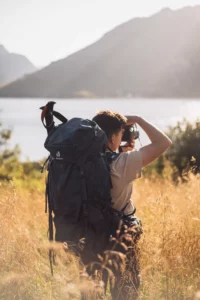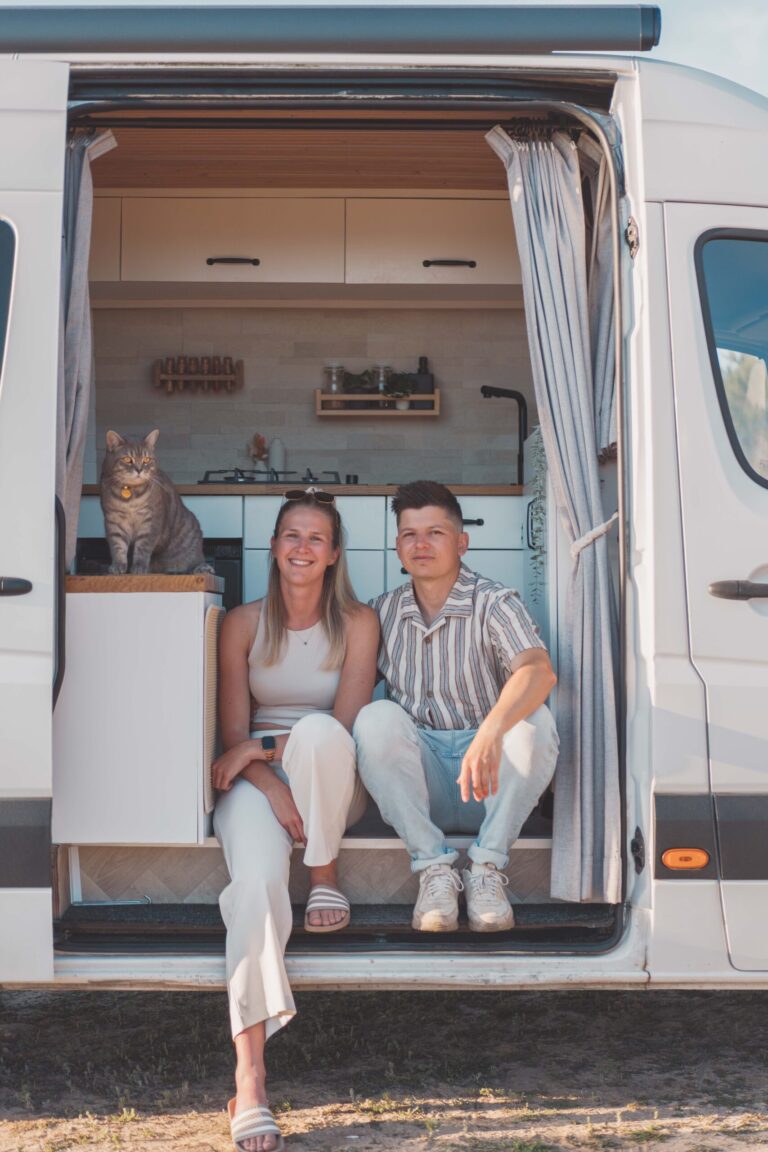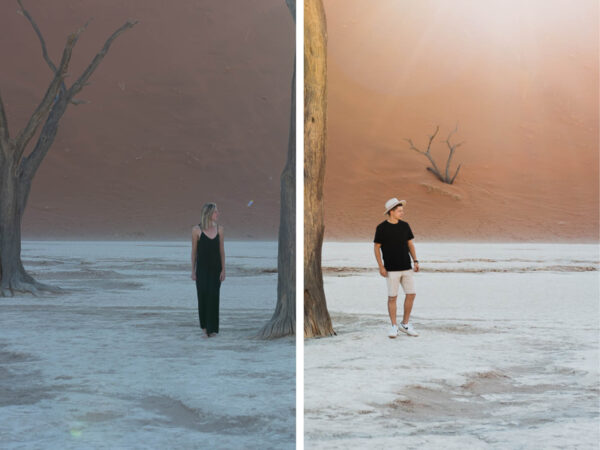62° 02′ N, 07° 01′ W
Overview
This post may contain affiliate links, which means we may receive a small commission, at no extra cost to you, if you make a purchase through our link.
This is a free way to support us and allows us to continue creating even more inspiring travel guides. Thank you for supporting the love we put into Coordinotes!
8-Day Faroe Islands roadtrip
This Faroe Islands itinerary covers all the must-see spots, hidden gems, and incredible landscapes the islands have to offer. You can follow the route in either direction, so feel free to adjust it to your own adventure. We made a road trip around the Faroe Islands with a rooftop tent and included the best campsites to stay at along the way. Get ready for breathtaking cliffs, cozy villages, and unforgettable views!
Tórshavn
Tórshavn & Tinganes
On your first day on the Faroe Islands, you can explore and stroll around in the city center of the capital Tórshavn. We are usually not city dwellers, but this city was a charm to us. It is a quiet and cozy city, especially a part of the city called Tinganes.
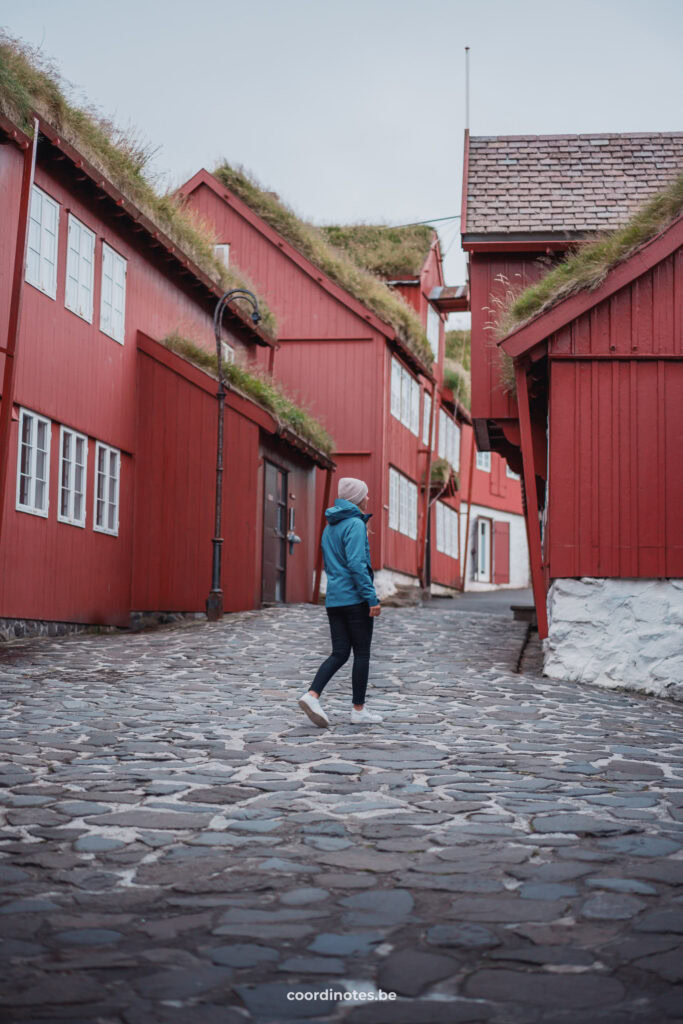
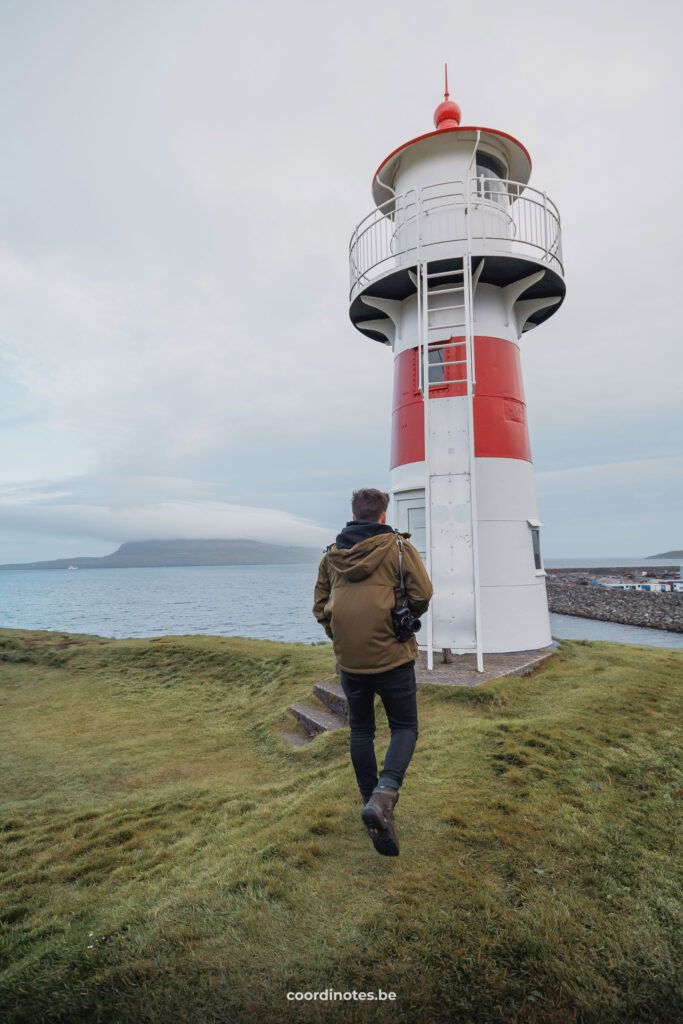
Tinganes is a peninsula in Tórshavn, where the government of Faroe Islands is located. It is the oldest part of the city and has many alleys like the one in the picture. Also, the cathedral of Tórshavn is located here.
Practical
Camping Tórshavn:
- 120DKK per adult
- 50DKK for electricity
- Shower: 10DKK for 4 minutes
- Payment at the reception during opening hours or you can make a reservation and pay here.
Note: Most of the campsites can be paid online or by card during the opening hours of the reception. But at some campsites you have to pay for the shower with coins. Receptions are not open 24 hours and some of the campsites don’t even have a reception. Therefor it is always useful to have a few coins with you.
No time to read now?
Save this post on Pinterest!

Suðuroy: Rituskor & Lopranseiði
Rituskor
Rituskor is a cleft on Suðuroy island, elevating 289 meters above the ocean. To reach the cleft you’ll have to cross a narrow wooden bridge over the gap between Rituskor and Suðuroy mainland. From here you have a breathtaking view of the Ásmundarstakkur sea-stack.
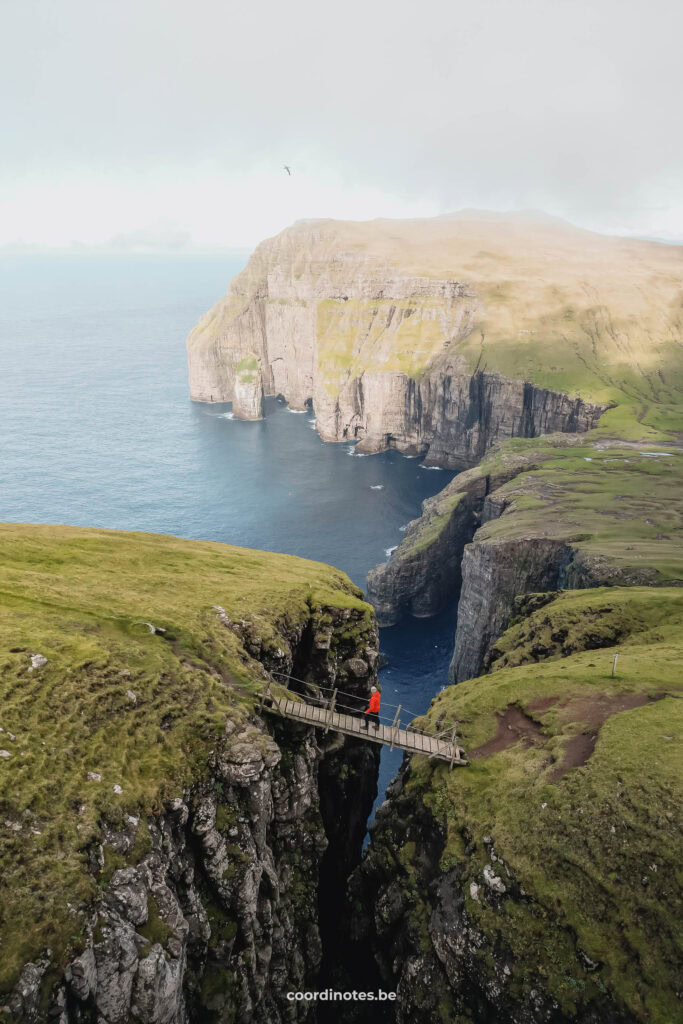
Lopranseiði
On the west coast of Suðuroy islands, located to the west of Lopra you find Lopranseidi. It is a gorgeous place where you can enjoy the peace with a beautiful view towards the west coast of Suðuroy. During summer you can see many birds flying around this place. We got some real Jurrasic Park vibes in this place.
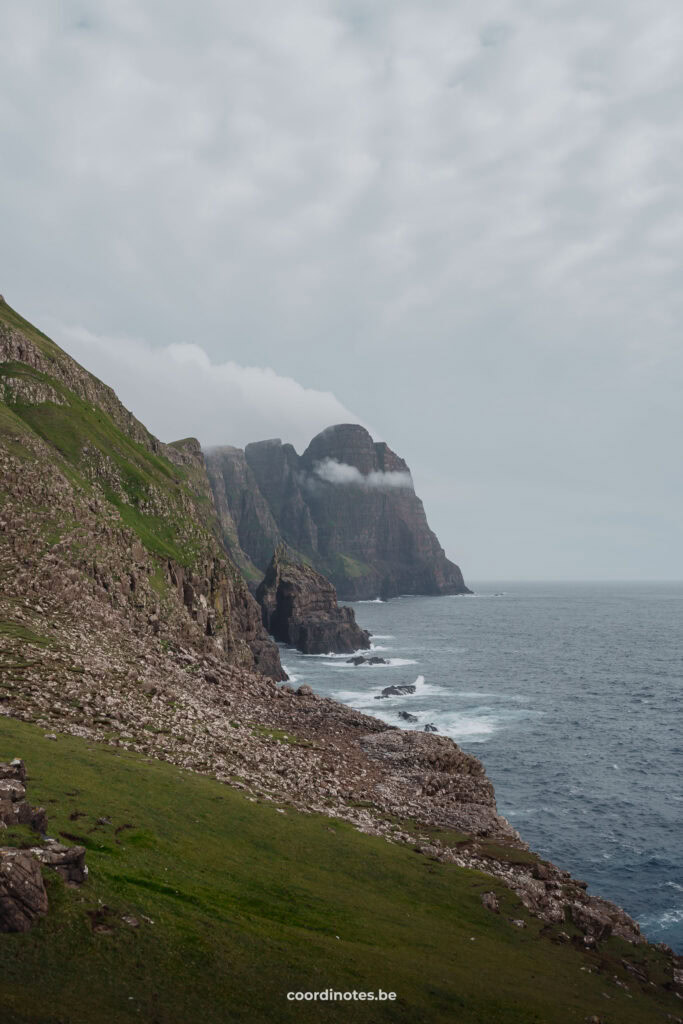

Practical
Suðuroy Island is the southernmost of the 18 Faroe Islands. To get to Suðuroy you will have to take the ferry Smyril in Tórshavn. The sailing time is 2 hours and the trip is an experience on its own. During this trip you pass one third of all of the Faroe Islands and you can enjoy the fresh sea breeze.
The timetabel for the Smyril ferry can be found here.
Price "one way":
- Car (driver included): 225DKK
- Adult: 80DKK
Payment is made when entering the boat with a member of staff.
Sail time is about 2 hours
You can take the ferry back to Tórshavn the same day (don't forget to make a reservation, or queue for the last boat) and stay at Camping Tórshavn (this is what we did). Or you can spend the night at one of the campsites on Suðuroy.
Tip: We advice you to make a reservation for the ferry a few days in advance as it can be sold out. For the return trip it is often not possible to book the last boat of the day as this boat is reserved for cargo. Iff you want to have this last boat, you can queue and hope there will still be places left (this is what we did too).
Kirkjubøur, Nordradalsskard, Eiði
Kirkjubøur
Kirkjubøur is the southernmost village of the island Stremoy. This charming little village has played a big role in the history of the Faroe Islands. It is characterized by the traditional, black houses with turf roofs and the old Farmhouse, one of the oldest inhabited wooden houses in the world.
The village is also known for the ruins of the Gothic Saint Magnus Cathedral and Saint Olav’s church, the oldest church of the Faroe Islands. So there are many reasons to visit this lovely village!
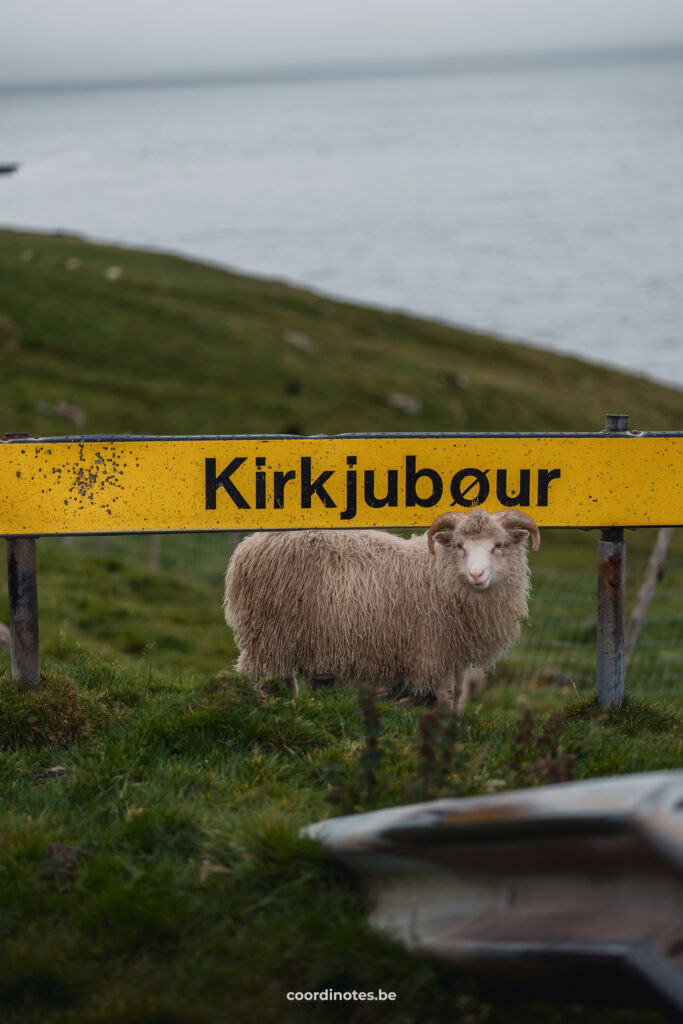

Nordradalsskard
Norðradalsskarð is a mountain pass on Streymoy Island, leading to Norðradalur valley. It is one of the most winding roads on the Faroe Islands. The pass is located 270 meters above sea level and the total distance to the valley is 2,4km.
From this pass, you will have an incredible view of the deep valley and the small island of Koltur in the background.
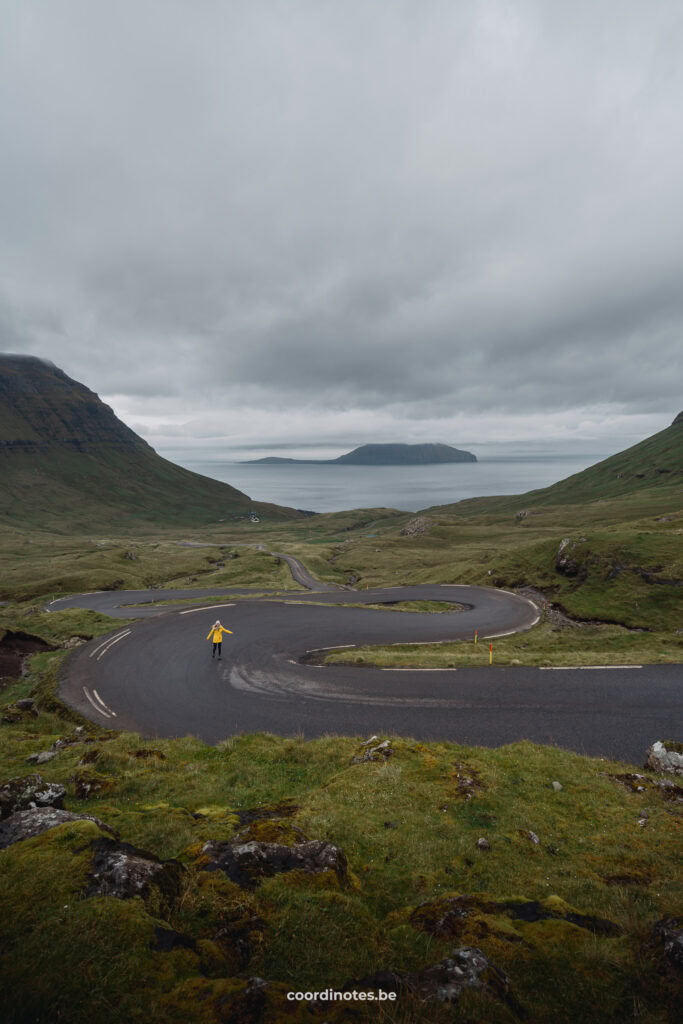
Eiði
Eiði is a village on Eysturoy Island. Here you will find the famous football field campsite nestled next to the Atlantic Ocean, where can stay the night. Behind the football field, you can start a hike that will take you around the corner with a beautiful view on the edge of the island with a waterfall that spills straight into the ocean.
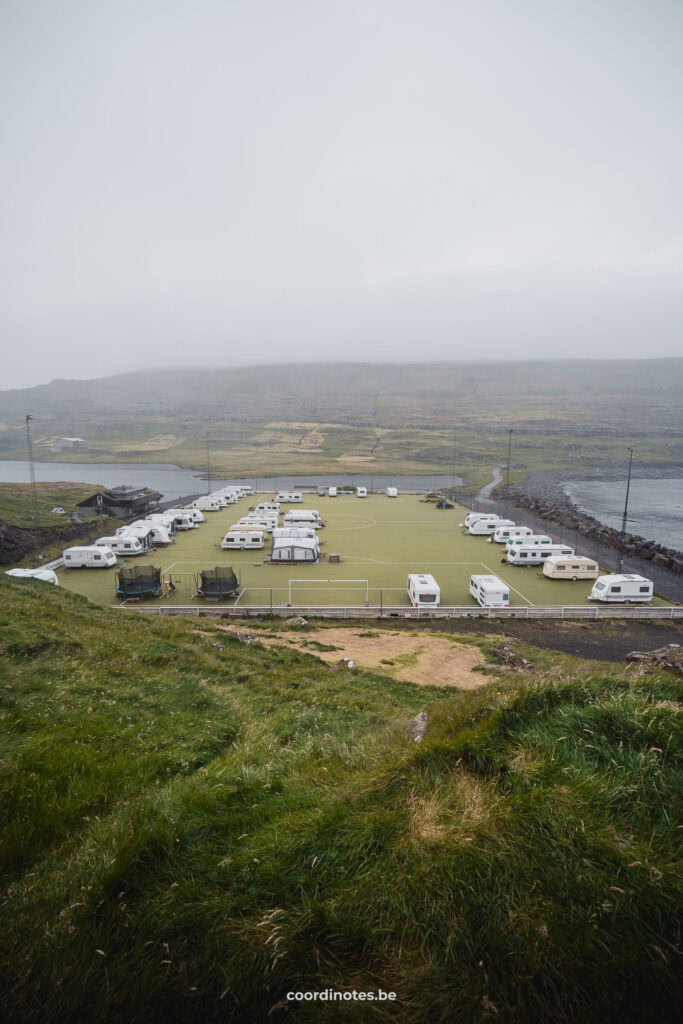
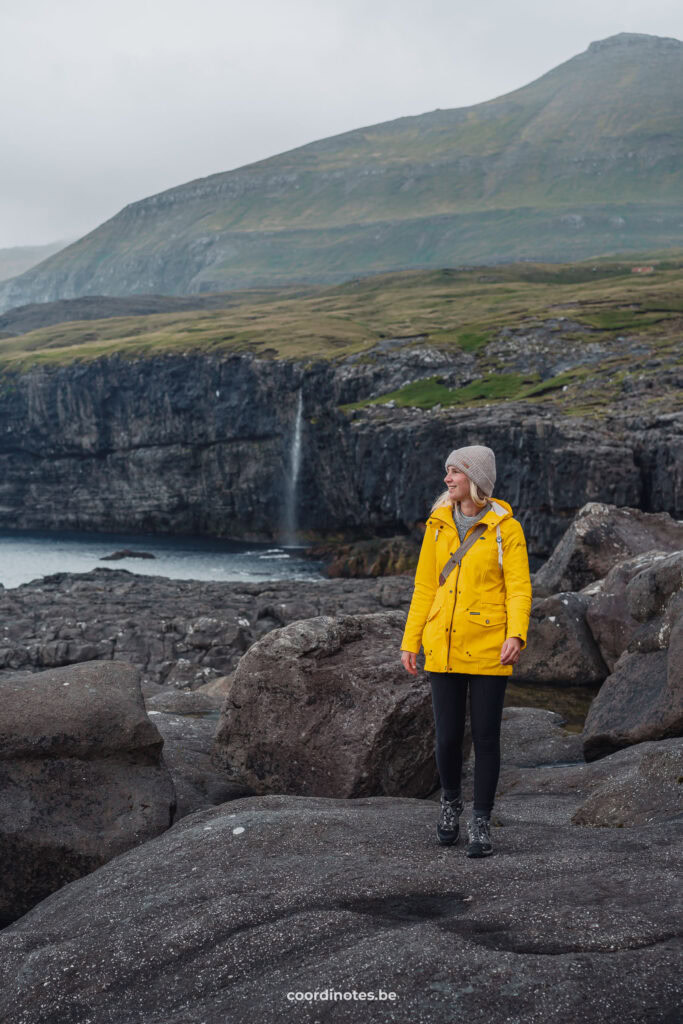
Practical
Spend the night on a soccer pitch!
Camping Eiði:
- 240DKK per campervan
- Shower and toilets are included in the price
- Communal Kitchen
- No Reception: Payment can be made by scanning a QR-code at the campsite and there will be a host passing by in the evening.
Or you can make a reservation and pay here.
Kalsoy: Kallur Lighthouse, Mikladalur
Kallur lighthouse
Kallur Lighthouse is a lighthouse on the island of Kalsoy. This island has some impressive sheer cliffs and dramatic peaks. The lighthouse in the middle of this setting is one of the most famous images of the Faroe Islands. To reach the lighthouse, you’ll have to walk for less than 1 hour while you can enjoy some breathtaking views along the way.
Interesting fact: This place was a filming location for the James Bond film: No Time to Die. You can actually find a tombstone of James Bond close to the lighthouse, on the ridge towards the peak behind it.
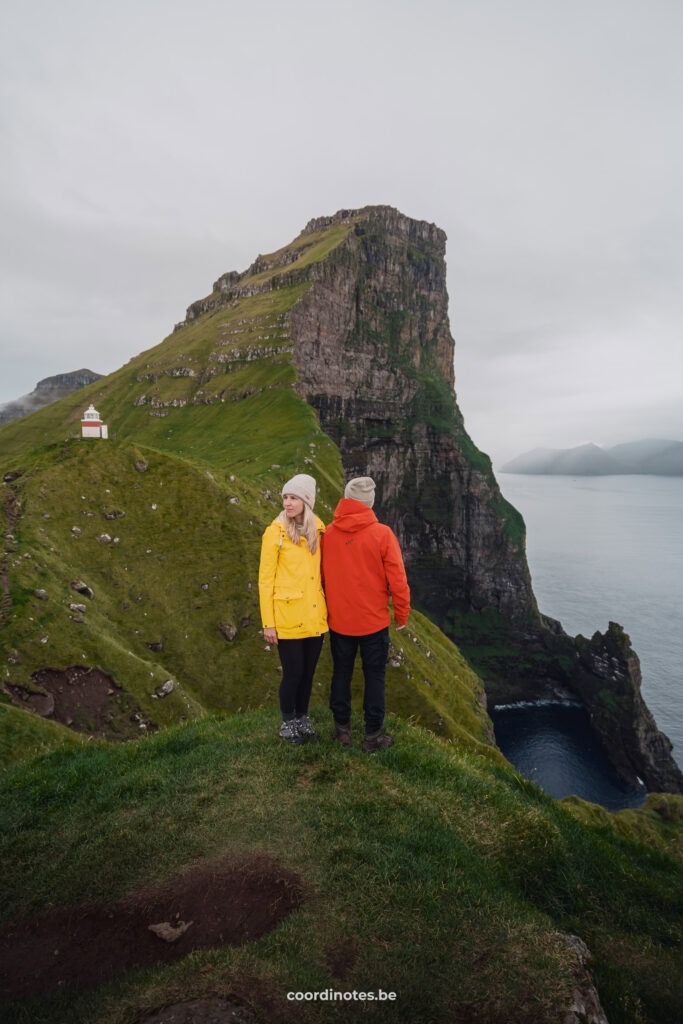
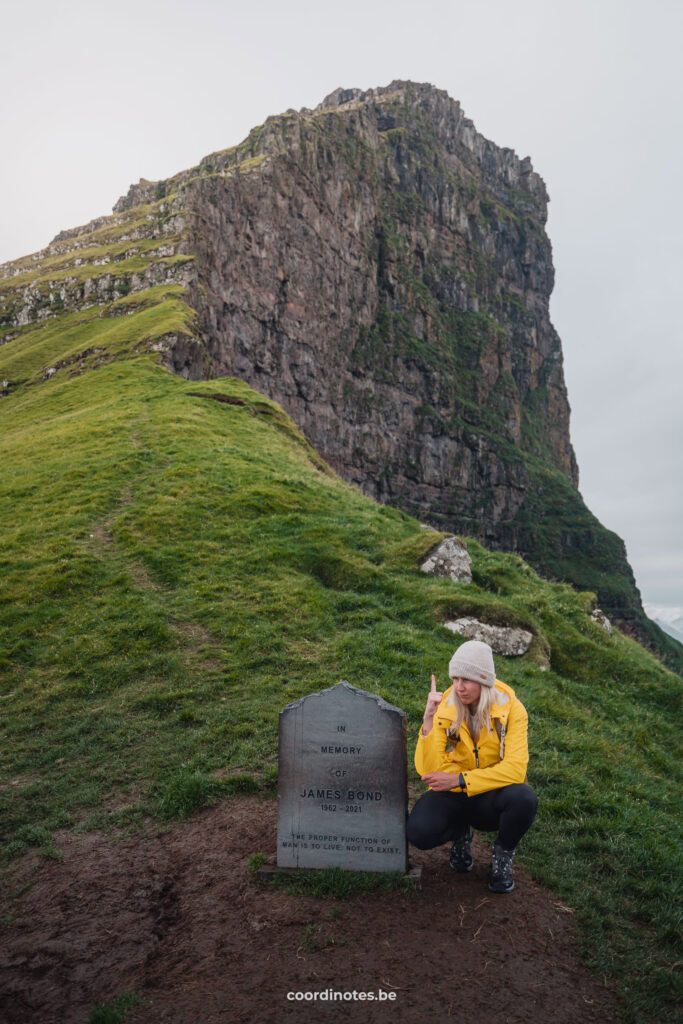
Mikladalur
We didn’t plan to visit Mikladalur but as we missed the last ferry back to Klaksvík, we had to stay the night here. And we have to admit that we loved staying here. It is a charming little village where you will find Kópakonan, the statue of the Seal woman.
In the village there is a Public Rest Stop with a vending machine for a snack or a drink and where you can sit inside warmly and charge your electrical devices if you are staying on the campsite.
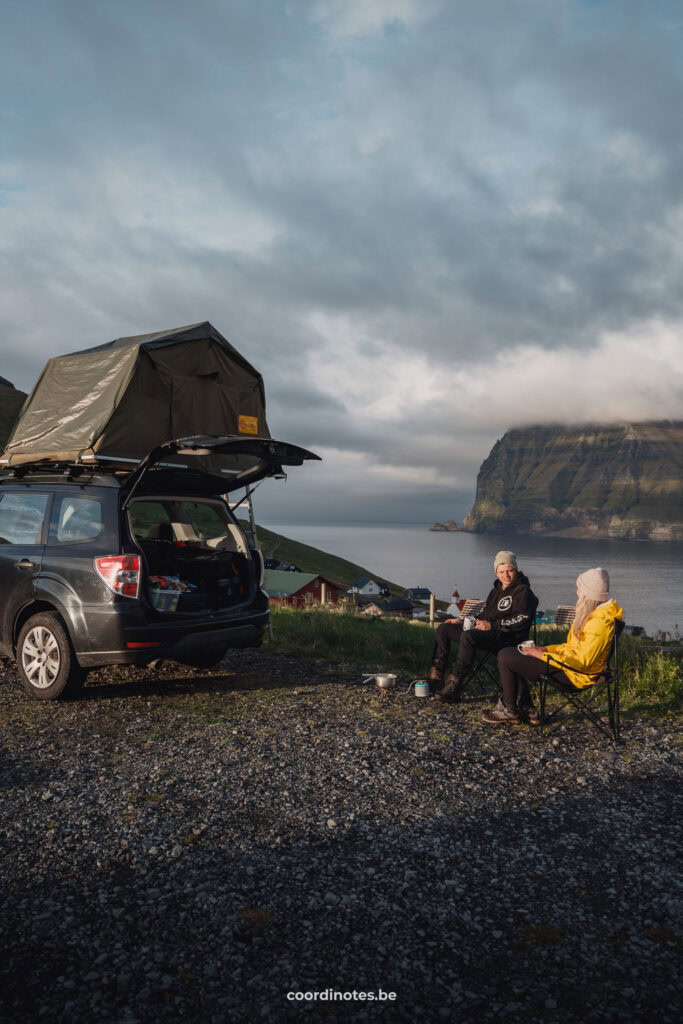
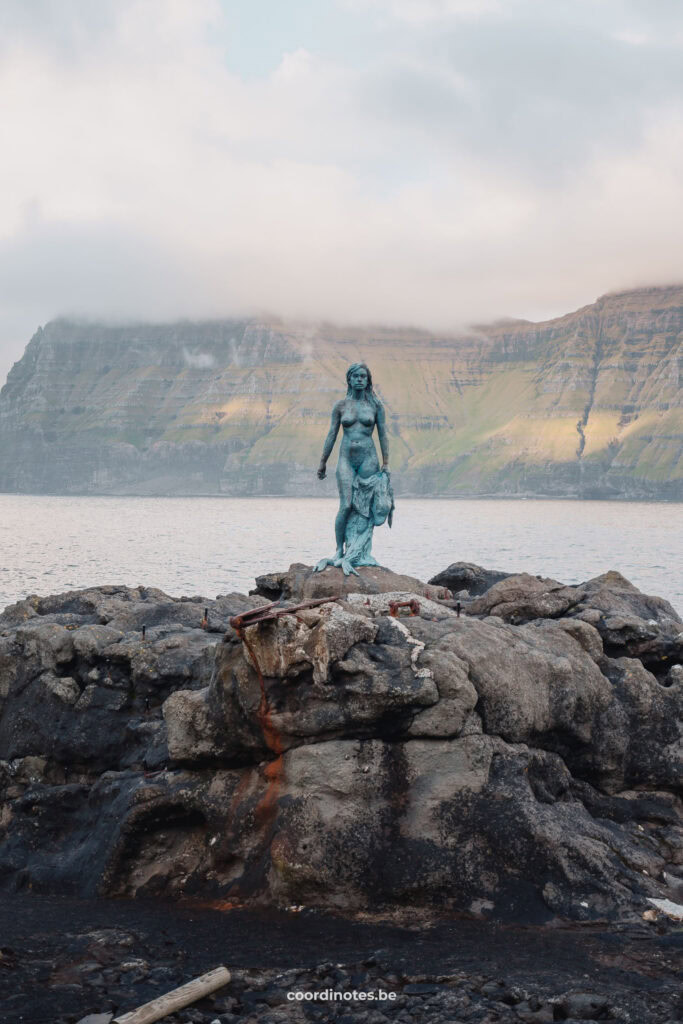
Practical
In order to get to Kalsoy island, you have to take the ferry SAM to Syðradalur in the city of Klaksvík. It has several daily departures. On Mondays, Wednesdays, and Fridays it sails eight times, and less frequently on the other days.
You can find the timetable here. (Note that there is a summer and a winter schedule!)
Price: 160DKK return trip for a car + driver.
Adult: 40DKK.
You have to pay a member of staff when you drive on the boat.
Sail time: 20 minutes
It is recommended to be in Klaksvík at least one hour prior to departure if you want to bring a car to Kalsoy, as the ferry has a limited capacity of only 12 vehicles. Once you are in the queue, you can leave your car and explore a little of Klaksvík on foot.
Camping Mikladalur:
- 200DKK per campervan
- Toilet and shower included
- No kitchen
- There's a camping house with a kitchen in the area but is not included in the camping experience. It has to be booked in advance.
- No reception: Payment has to be made online by scanning a QR code at the campsite or you can make a reservation and pay here.
Note: From the parking lot of the Kallur Lighthouse trailhead to the ferry port in Syðradalur is a 20 minute drive. If you make it back in time for the last ferry back to Klaksvík, you can stay the night at the camping of the next stop Gjógv, or a campsite on your way there (for example Camping Fuglafjarður). If you don’t make it in time for the last ferry, you can stay the night on camping at Mikladalur (like we did). You can take the ferry back the next morning, but make sure to check the timetable.
Gjógv, Hvithamar, Fossá
Gjógv
Gjógv is the literal translation of ‘rock gorge’. It is the northernmost village of the island of Eysturoy, located at the end of a deep valley. In this lovely village, you find a 200-meter-long gorge that has been used as a natural harbor. You can enjoy a beautiful hike next to the village to get a stunning view over the valley and the west side of Kalsoy, where you were the day before.
There’s a hiking trail next to the village. Note that this trail is on privately owned land. You have to pay 50DKK per person in cash in a letterbox. The money is used for the maintenance of nature and the trail.
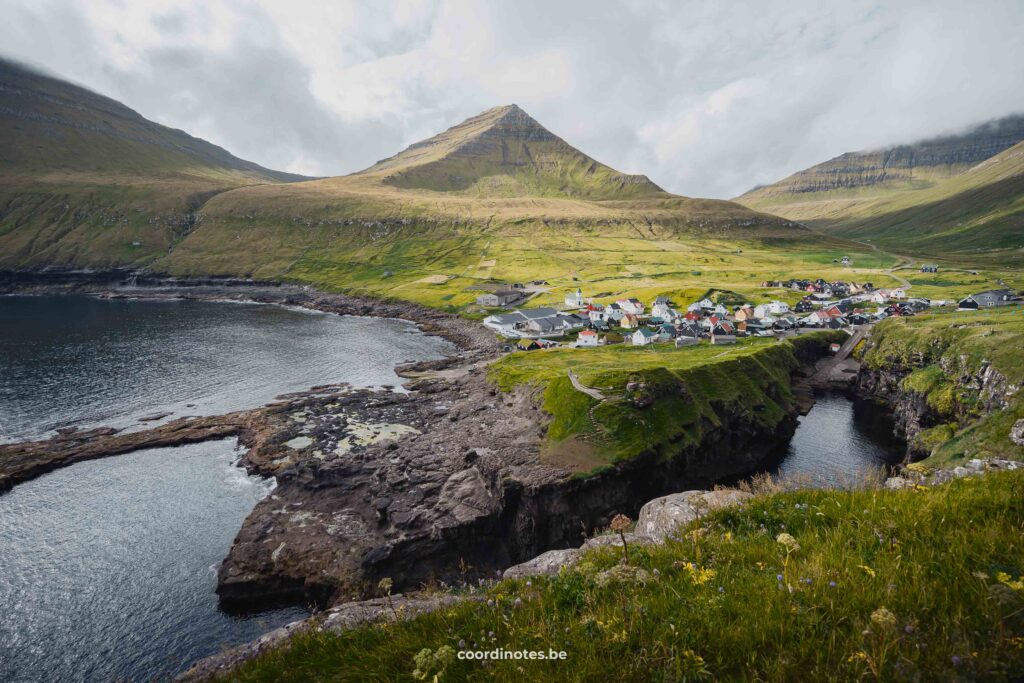
Hvithamar
On the ridge of Mount Hvíthamar, above the village of Funningur, you will find this beautiful viewpoint. From here you have a beautiful view over the fjord Funningsfjørður, Slættaratindur, and the surrounding mountains. The best part? You only have to hike a short distance uphill from the Gjáarskarð mountain pass to reach the viewpoint and enjoy the breathtaking view of the area.
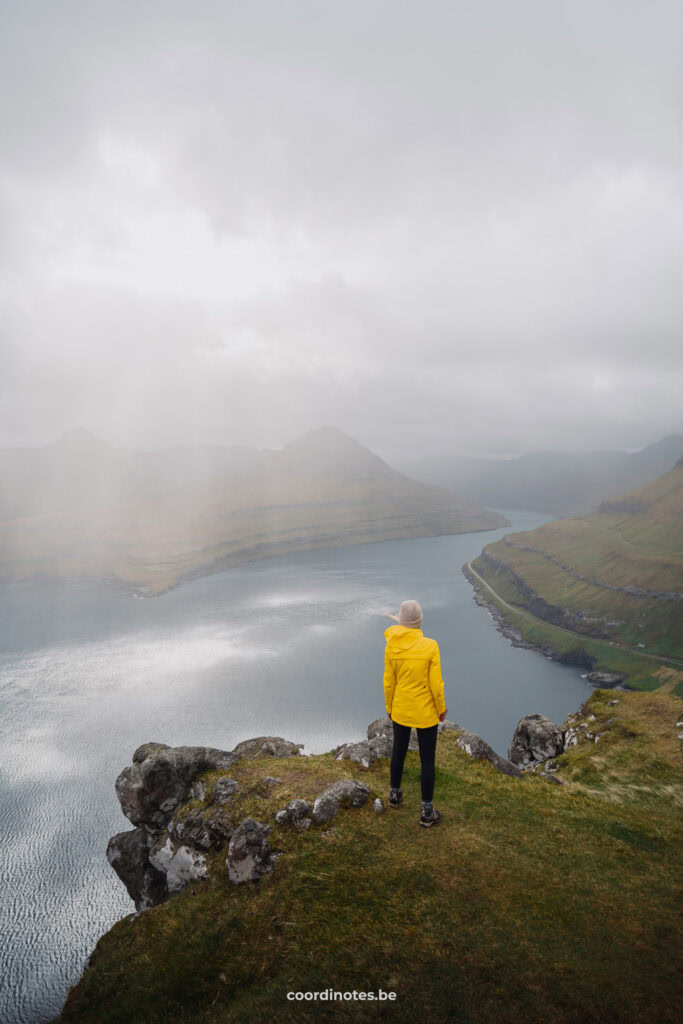
Tip: If you are navigating to this place on Google Maps, do not type in Hvithamar, but look for Gongutúrur / Hvithamar Trailhead, Funnings kommuna, Faeröer.
Fossá
Fossá is the tallest waterfall in the Faroe Islands. It is a two-level drop waterfall on Stremoy Islands. This gorgeous waterfall is known for its impressive formation but also for its dark basalt wall. It is easily accessible and you can get really close to the spraying water.
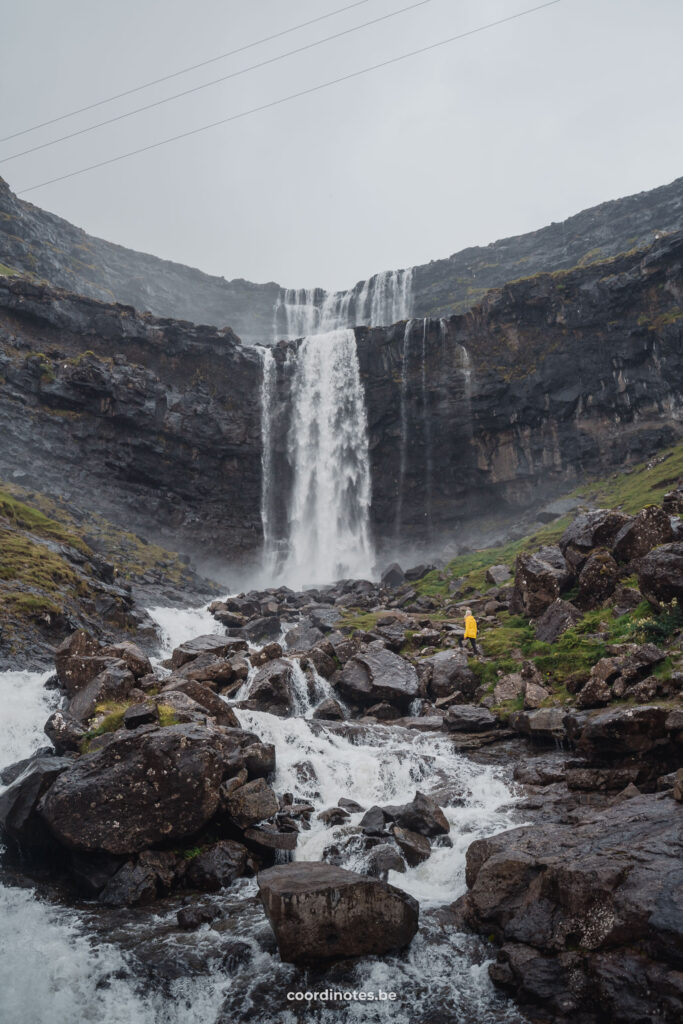
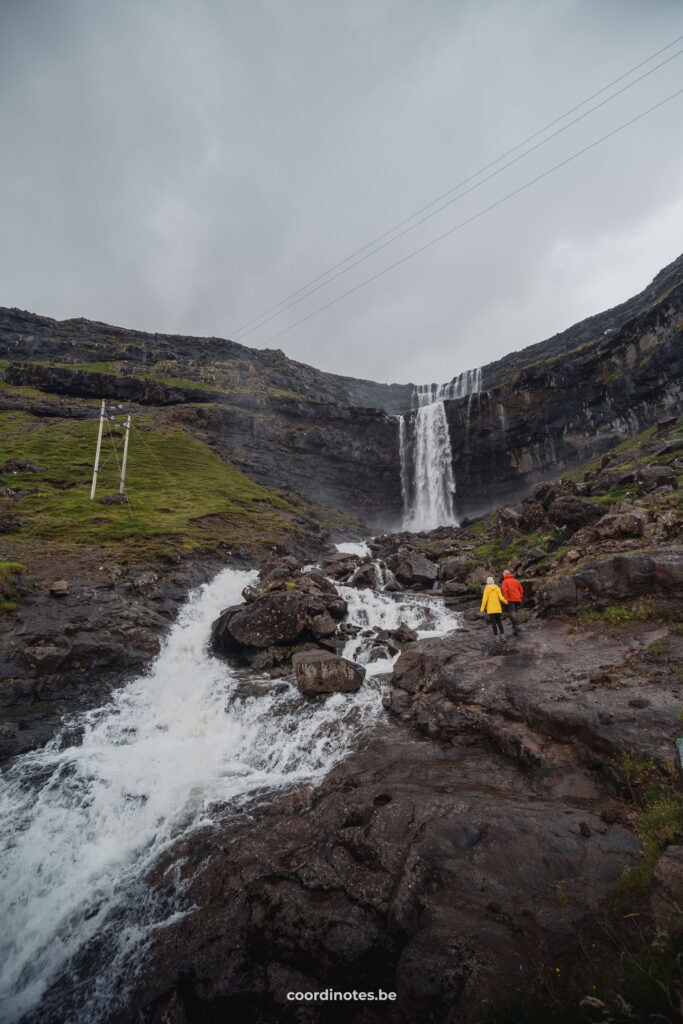
Practical
Camping Vestmanna
- 100DKK per adult
- Shower: 20DKK for 6 minutes
- Communal kitchen
- Payment: There will be a host passing by for payment.
Interesting Fact: The word Fossa is the Faroese word for waterfall.
Vestmanna sea cliffs, Sørvágsvatn
Vestmanna Sea Cliffs
The Vestmanna Sea Cliffs are gigantic cliffs that shoot over 600 meters straight out of the ocean. The cliffs have some impressive arches and big caves, carved by the waves through the ages. During summer, huge colonies of seabirds have their home on the cliffs.
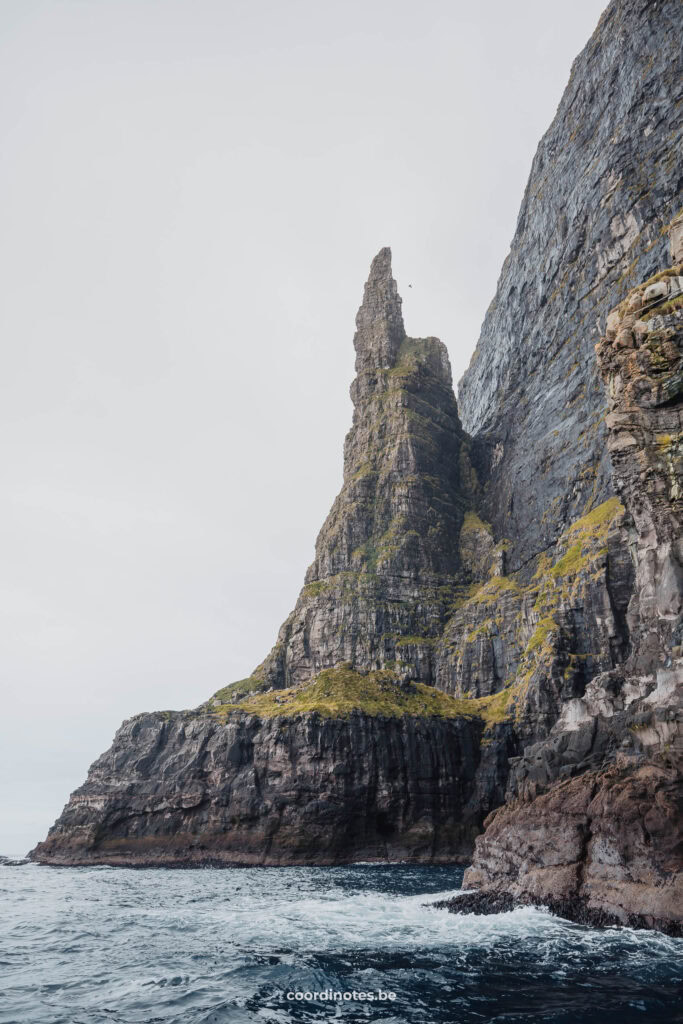
You can take a boat tour of these cliffs, which will take you into the grottoes and along the sea arches and cliffs. You will see many seabirds and sheep on the steep edges of the cliffs. If you’re lucky, you might even see some seals in the water.
You can book your boat tour on this website.
The price of the classic tour is 398 DKK. Make sure to book your tour in advance as tours can be sold out quickly.
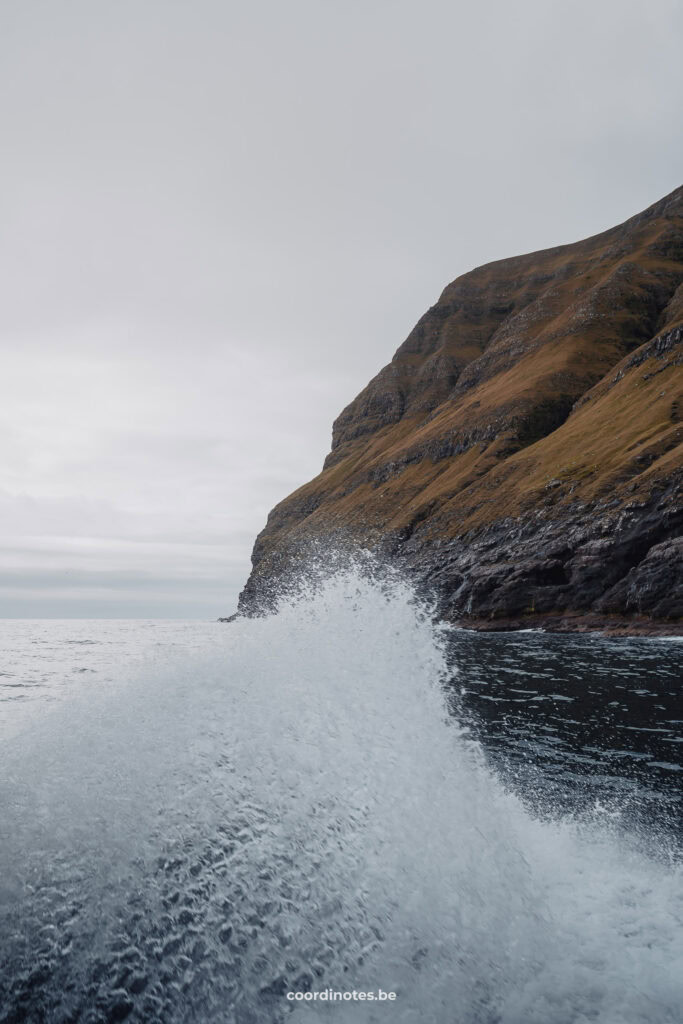
Sørvágsvatn
Sørvágsvatn is the largest lake in the Faroe Islands. It is also known as ‘Lake above the Ocean’ and is probably one of the most famous sights of the Faroe Islands. This stunning lake sits close to the edge of a cliff, about 30 meters above sea level. From the right perspective, this creates the optical illusion that the lake is floating above the ocean.
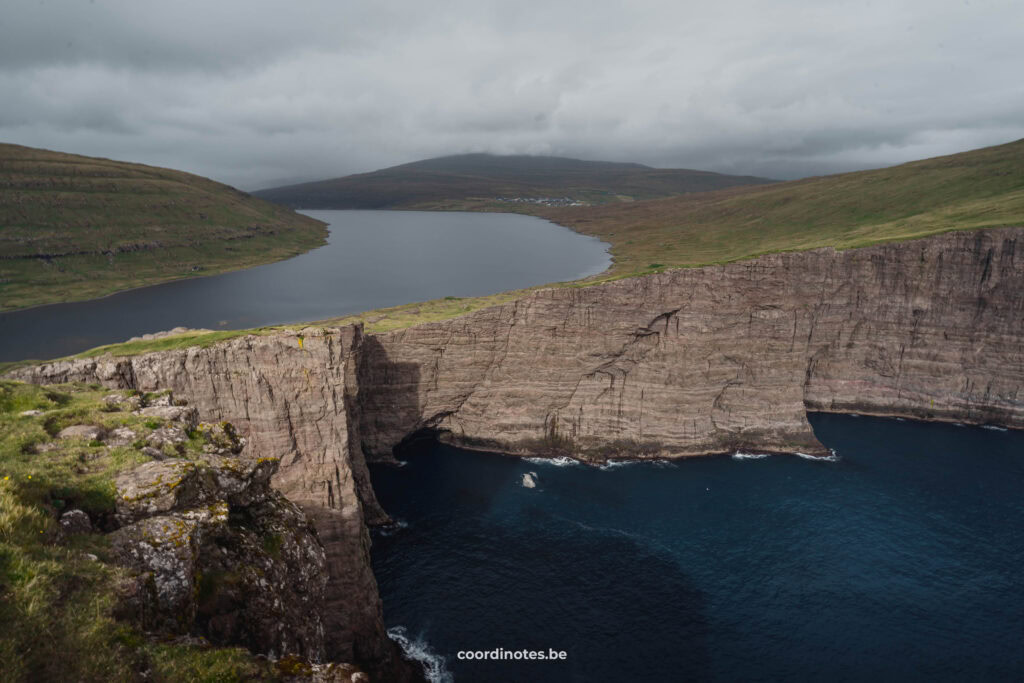
The Sørvágsvatn hiking trail is relatively easy. There are a few parts that can be slippery and muddy, especially on rainy days.
Visitors must pay a fee of 200 DKK when hiking the trail. The payment is collected in cash or by card at the beginning of the trail, next to the parking lot.
Please! Be extremely careful when hiking around the cliffside edge, especially when it’s windy!
7 km
543 m
543 m
3 to 4 hours
Out & Back
Easy - Moderate - Difficult - Expert
Practical
Camping Giljanes
- 100DKK per adult
- Toilet and shower included
- Communal kitchen
- Payment: There will be a host passing by for payment.
Note: It is also a hostel where you can rent a room or bunk bed. We really loved this campsite as you can meet a lot of other like minded travelers and backpackers here. And they have a cute house cat with thumbs, called Felix!
Mykines
Puffins and hiking on Mykines
Mykines is the most western island of the Faroe Islands and it is the place to be to see puffins from really close by. It is one of, if not the most beautiful and unique islands of all 18 islands with the most unspoiled landscapes. On Mykines you can stroll through the old village with turf-roofed houses and hike in unspoiled nature. In summer it is the perfect place to go bird watching as it is home to thousands of puffins and many other sea and land birds.
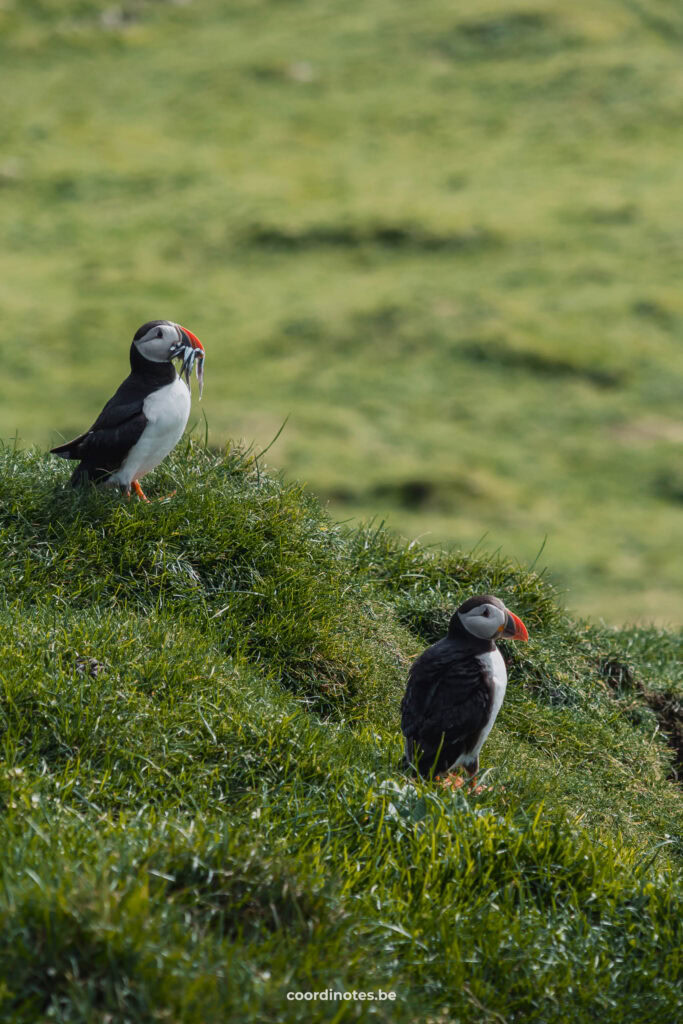
Hiking on Mykines island is only allowed with a guide and each traveler who wants to hike in Mykines has to pay a hiking fee. A tour with a guide including the hiking fee costs 400 DKK, if you book it in advance. You can also pay on arrival, but then the price is 500 DKK. You can book your hike on hiking.fo. This means that you also have to pay if you want to see the puffins. Note that there are only 200 visitors per day allowed on the island, only between 10 am and 5 pm.
Practical
400 DKK guide + hiking fee per person
Mykines has practically no roads, so there are no cars on the island. Therefor you are only able to take a ferry on foot.
The boat trip in itself is already worth it. During this trip, you will sail by the island Tindhólmur, better known as the sleeping dragon, and the famous sea stack of Drangarnir along the way. Maybe you can even see some puffins catching fish out of the water.
You can book your ferry on this website.
One way: 60DKK per adult
Sail time: 45 minutes
If you want to get to Mykines in a slightly more exciting way, you can also take a rib boat or even go by helicopter (which is definitely recommended, because it is actually not that expensive at all compared to other places).
Camping Giljanes
- 100 DKK per adult
- Toilet and shower included
- Communal kitchen
- Payment: There will be a host passing by for payment.
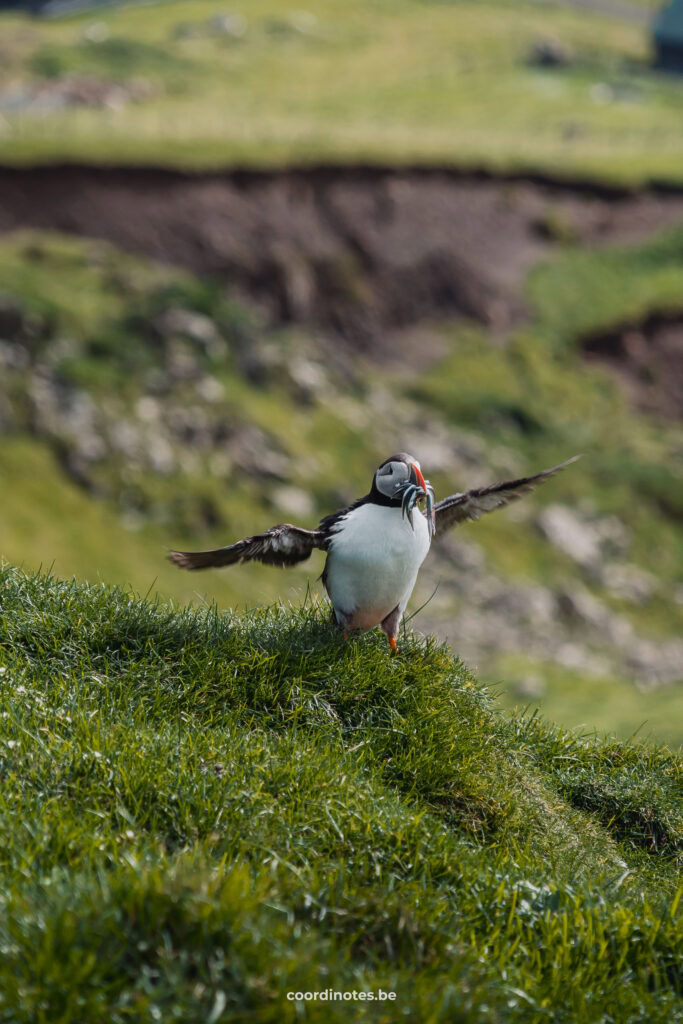
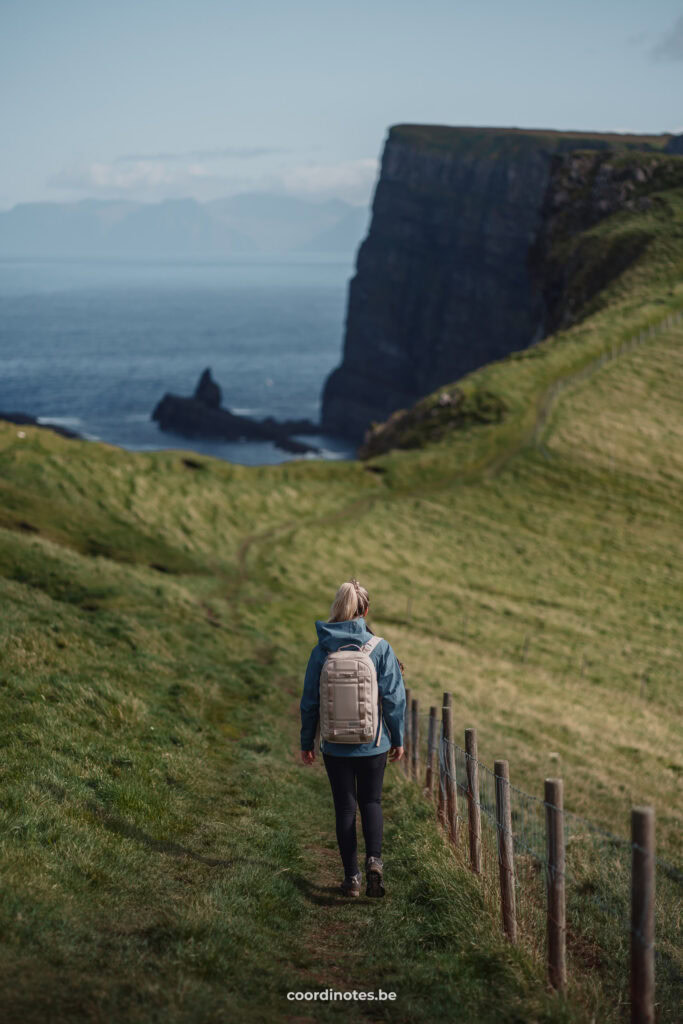
Tip: We recommend you to plan Mykines not on your very last day, because it is possible that the boat get canceled due to bad weather conditions. To be absolutely sure, you might even try to plan it at the beginning of your trip.
Dunnesdrangar, Múlafossur
Dunnesdrangar
Dunnesdrangar is one of the most beautiful places we’ve visited on the Faroe Islands. And the best part? It has not yet discovered by many tourists, so chances are you’ll have this place all to yourself
Dunnesdrangar are two sea stacks rising 70 meters out of the ocean. They are located on the west coast of Vágar. To reach this amazing scenery you have to walk 3 kilometers across the moor from the village of Sørvágur. It will take you about 1 hour to reach this stunning viewpoint.
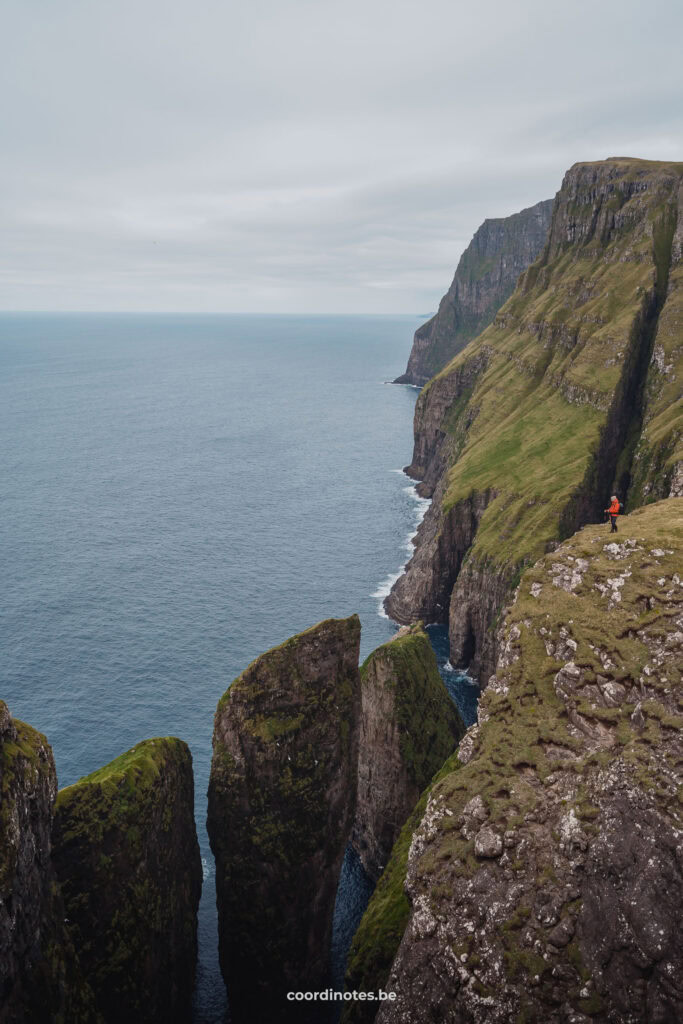
The hiking path to Dunnesdrangar is still unmarked as it is one of the best-kept secrets of the Islands, This makes it a little harder to find. The exact coordinates of the start of the hike are 62°03’51.0″N 7°17’58.6″W.
A little further you find two wooden logs, where you enter the meadows and moor. From here you have to keep on walking towards the sea (you can follow the fences or the river for a long time). You will have to cross (read: climb over) a few fences and pass a few creeks. Overall it is an easy walk and you will be rewarded with an incredible view.
Please! Be extremely careful when hiking around the cliffside edge, especially when it’s windy!
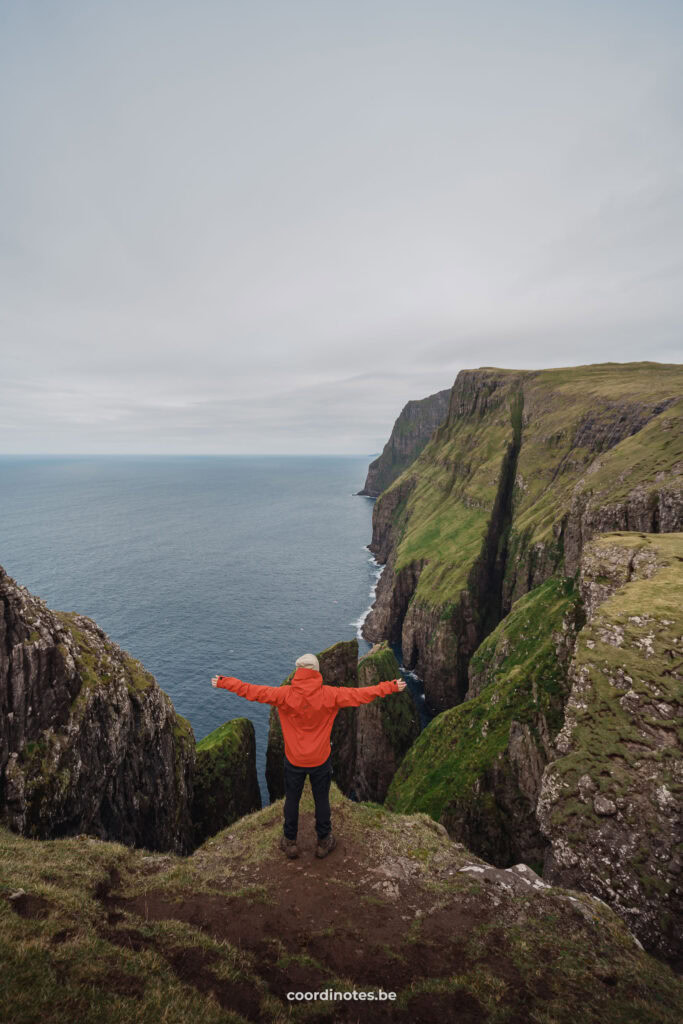
Múlafossur
If you’ve ever seen a picture of the Faroe Islands before, it’ll probably have been a picture of Múlafossur waterfall. This waterfall is located in Gásadalur and it is probably the most famous attraction of the Faroe Islands. The small stream of the waterfall falling into the huge ocean creates this gorgeous scenery, that you must have seen when you visit the Faroe Islands. It is a beautiful ending to this amazing Faroe islands Itinerary.

Practical information for a Faroe Islands road trip
Where and what are the Faroe Islands?
The Faroe Islands are a group of 18 islands in the North Atlantic Ocean, between the UK and Iceland, and are a part of the Kingdom of Denmark. Faroe Islands almost literally means sheep islands, which is not surprising since there are more sheep than people living on the islands. Besides the sheep, the islands also have some of the most unique landscapes you’ve ever seen, with vertical drop-offs and cliffs rising straight from the Atlantic Ocean.
The best time for this Faroe Islands itinerary
We went on this Faroe Islands trip at the end of August. You can complete this 8 day itinerary during the summer months from June to August. During this period you have the best chance of good weather, but this is never guaranteed on the Faroe Islands. If you plan on going during the winter months, temperatures remain quite mild, but it can be very wet. Also, the days will be shorter, so you’ll have less time to explore and many campsites will be closed.
If one of your main purposes of visiting the Faroe Islands is to see puffins, you have to visit somewhere between April and August during the breeding season. The rest of the year these gorgeous birds return to live on the sea.
Also, bear in mind that the weather in the Faroes can be very different from place to place. In one place it can be extremely foggy, while in another place the sun shines. It is not exceptional to experience four seasons in one day.
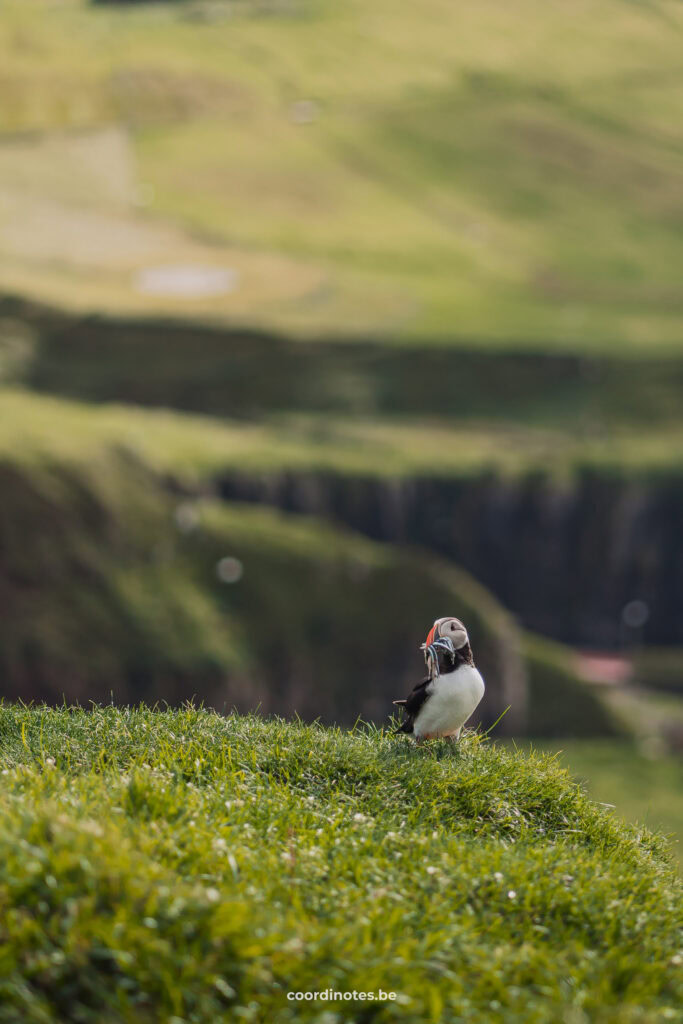

Driving on the Faroe Islands
The islands are connected by a great infrastructure of roads, tunnels, and bridges.
These are all well-maintained and it is very quiet on the roads. All major highways are paved, but some roads, especially the smaller villages are still gravel roads.
Keep in mind that some roads and tunnels can be very narrow and you should adjust your speed to the circumstances. Some villages with narrow roads do not allow large vehicles such as camping cars. The very narrow roads all have lay-bys, where you can pull up to let another vehicle pass by. Please, remember that these lay-bys are not to be used for parking!
You have to drive on the right-hand side and your lights has to be turned on all the time. The speed limit on the main roads is 80km/h and 50km/h in villages. Off-road driving on the Faroe Islands is prohibited by law. Apart from some sharper turns every now and then, it is still quite easy to drive on the Faroe Islands as long as you adjust properly to the circumstances (gravel, narrow roads…). And be aware of the sheep as they are not afraid of suddenly crossing or standing still in the middle of the road.
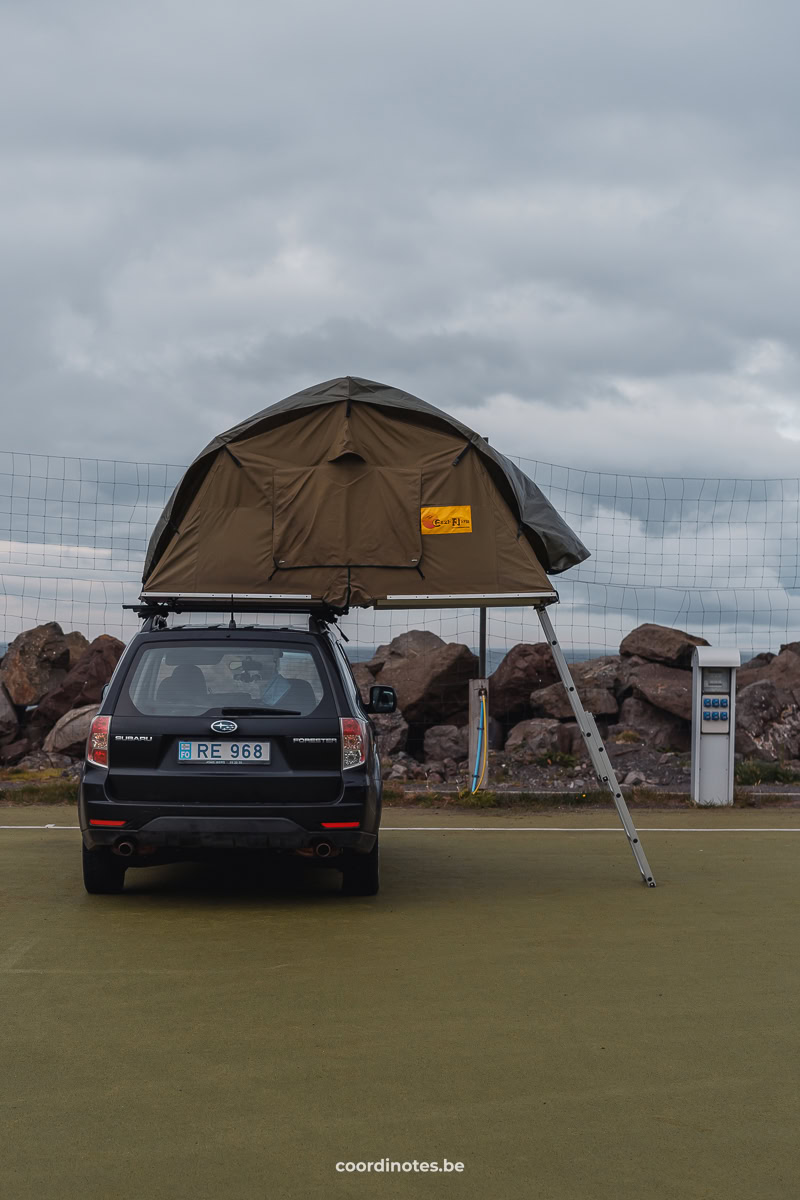
Tunnel Toll
There are three sub-sea tunnels for which you have to pay:
- Eysturoyartunnilin between Streymoy and Eysturoy: (You are charged every time you drive through the tunnel)
- Stremoy to Eysturoy: 175DKK for a car (<6m)
- Strendur to runavik 125DKK for a car - Vágatunnilin between Streymoy and Vágur: 100DKK for a car (Return trip: you are only charged when driving from Vágur)
- Nordoyatunnilin between Eysturoy and Borðoy: 100DKK for a car (Return trip: you are only charged when driving from Klaksvik)
You don't have to stop at the tunnels: A photo of your license plate will be registered. Many car rental companies have the option to buy this toll in advance, or their license plates are already registered and they will charge you afterwards. Make sure to check this with your rental company. If you are going with your own vehicle, you can pay for a single trip (online, before or after, no later than 6 days after you driving through the tunnel) or you can register automatic payment. All detailed information can be found on www.tunnil.fo.
Ferries
To reach some of the islands (such as Kalsoy, Suduroy and Mikines) you have to take a (car-) ferry. The ferry to Kalsoy has to be paid when driving on the ferry. For Suduroy and Mikines you have to make a reservation, that can be made and paid online. More detailed information about each of these ferries separately can be found later in this blog post when you have to take one in the itinerary.
Note: If you follow this exact itinerary, you’d normally have one return trip through every tunnel max. Depending on your navigation, you can skip the Eysturoyartunnilin, but this tunnel has the first sub-sea traffic roundabout in the world. So it might be worth driving by once if this interests you.
Renting a vehicle
There are a lot of companies where you can rent different kinds of vehicles: from regular cars and minivans to bigger campervans and 4×4 with or without rooftop tents.
Keep in mind that some roads are quite narrow and also for the ferries it is sometimes easier to have a smaller vehicle. In some villages with narrow roads (including Tjørnuvík and Múli), camping cars are not allowed. But it is definitely not impossible to drive around with a larger vehicle, such as a motorhome.
Which type of vehicle is best, depends entirely on if you want to make this a camping trip or rather a road trip with regular accommodations and how much comfort you would like to have yourself.
Feel free to reach out to us if you need help finding the right vehicle for your trip.

Camping on the Faroe Islands
Spread over the islands you find numerous hotels, hostels, guesthouses, b&bs, and campsites. We explored the islands with a 4×4 car with a rooftop tent. We have added the campsites to this Faroe Islands itinerary where you can either stay with a (rooftop)tent, minivan, campervan, or motorhome.
Camping is a fantastic way to explore the Faroe Islands. There are several campsites at some scenic locations, spread over the islands, with facilities such as showers and toilets. Most of these campsites also have a communal kitchen, where you can easily prepare your food, but also meet and have a chat with other travelers.
Nature on the Faroe Islands is beautiful, but also vulnerable at the same time. To protect this beautiful nature, wild camping is not allowed. More specifically are you not allowed to spend the night in camping cars or tents along roads, at rest stops, layby's, or view areas.
Campers are asked to only stay at the designated areas, to keep these places clean and not to leave any rubbish behind. Because of the changing weather, you have to prepare yourself and bring sturdy water- and windproof camping equipment. Keep in mind that some of the campsites are only for tents.
Remember that many of these campsites can be closed during winter!
As we explored the islands with a rooftop tent, we only stayed at campsites. Therefore we can not recommend any hotels or guesthouses. On the website of Visit Faroe Islands, you can find all the information about all other kinds of accommodations such as hotels, hostels, and guesthouses.
Phone service and roaming
There is nationwide coverage in the Faroe Islands, so nearly all the islands receive an excellent connection, with 3G and 4G networks. So even the most remote villages have mobile phone service. Just as everywhere in the world, there are a few places with less cell service, but overall service is good.
The Faroe Islands are NOT included in the EU free roaming agreement. Some countries/providers have roaming agreements, but this is something you have to check with your own provider. If it’s not included in your data bundle, buying a SIM card will be less expensive than roaming. At Vágar Airport you can buy a SIM card or you can get an e-SIM to be online again as soon as you set foot on the Faroe Islands.
Win-Win for everyone
Did you know that, if you buy or book something through our links, we receive a small commission?
However, you still pay the same and therefore have no extra costs! So a win-win for everyone. This way, we can continue to add even more travel inspiration and tips to this blog for your next adventure. Thanks a lot!
Thank you for visiting our blog
We hope you find our free travel guides and tips useful. If you want, you can support us virtually by ‘buying us a coffee‘.
Every contribution, no matter how small, is greatly appreciated and will help us continue to share our passion with you and grow this blog.
Win-Win for everyone
Did you know that, if you buy or book something through our links, we receive a small commission?
However, you still pay the same and therefore have no extra costs! So a win-win for everyone. This way, we can continue to add even more travel inspiration and tips to this blog for your next adventure. Thanks a lot!

